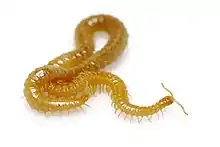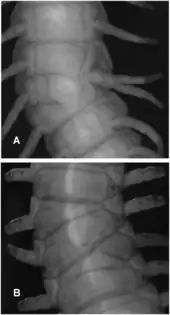Haplophilus subterraneus
Haplophilus subterraneus, commonly known as the western yellow centipede is a species of centipede in the family Himantariidae that can be found in Central Europe, Ireland, Newfoundland, Scandinavia and the United Kingdom.[1] It was recorded from a compost heap of the Botanical Garden at the University of Oslo at Teryen, Oslo in 1992 and 1995.[2]
| Haplophilus subterraneus | |
|---|---|
 | |
| Scientific classification | |
| Domain: | Eukaryota |
| Kingdom: | Animalia |
| Phylum: | Arthropoda |
| Subphylum: | Myriapoda |
| Class: | Chilopoda |
| Order: | Geophilomorpha |
| Family: | Himantariidae |
| Genus: | Haplophilus |
| Species: | H. subterraneus |
| Binomial name | |
| Haplophilus subterraneus (Shaw, 1794) | |
| Synonyms[1] | |
| |
It was for some time known as Stigmatogaster subterranea, but the name was reverted back to Haplophilus subterraneus in 2014.[3][4]
Description
It is fairly large, measuring up to, and sometimes exceeding, 70 mm in length. It has 77 to 83 leg pairs. It can be distinguished from other species by its clear [4]
Distribution
Haplophilus subterraneus is widespread in central and eastern Europe, along with the British isles, and has also been introduced to Newfoundland and New York.[5][6] It is common in woods and grassland habitats, and is also commonly found in gardens and other syanthropic habitats.[7][8]

Morphological anomalies
Several papers have reported high levels of morphological anomalies in H. subterraneus. One study found that on average, 30% of individuals may have some kind of anatomical deformity.
References
- A. D. Barber (2013). Barber AD (ed.). "Stigmatogaster subterranea". World database of littoral Myriapoda. World Register of Marine Species. Retrieved June 23, 2013.
- Kjell Magne Olsen (2000). "Haplophilus subterraneus (Shaw, 1789), a centipede (Chilopoda, Geophilomorpha) new to Norway". Norwegian Journal of Entomology. 47: 63–64.
- Barber, A.D. (2014). "GEOPHILOMORPHA OF EUROPE: SOME SYNONYMIES AND NAME CHANGES" (PDF). Bulletin of the British Myriapod & Isopod Group. 27: 62.
- "Haplophilus subterraneus (Shaw, 1794) | British Myriapod and Isopod Group". www.bmig.org.uk. Retrieved 2023-01-10.
- Tuf, Ivan Hadrián; Tajovsky, Karel (12 April 2016). "An annotated checklist of the centipedes (Chilopoda) recorded in the Czech Republic" (PDF). Acta Soc. Zool. Bohem. 80: 45–50. ISSN 1211-376X.
- Andersonian Naturalists of Glasgow.; Glasgow, Andersonian Naturalists of; Society, Glasgow and Andersonian Natural History and Microscopical; Society, Glasgow Natural History; Glasgow, Natural History Society of (2002). The Glasgow naturalist. Vol. 24. Glasgow: Glasgow Natural History Society.
- London Natural History Society.; Society, London Natural History (2001). London Naturalist. London: London Natural History Society.
- "MORPHOLOGICAL ANOMALIES IN HAPLOPHILUS SUBTERRANEUS (SHAW, 1794) (CHILOPODA: GEOPHILOMORPHA)" (PDF). Bulletin of the British Myriapod & Isopod Group. 26: 54–55. 2012.